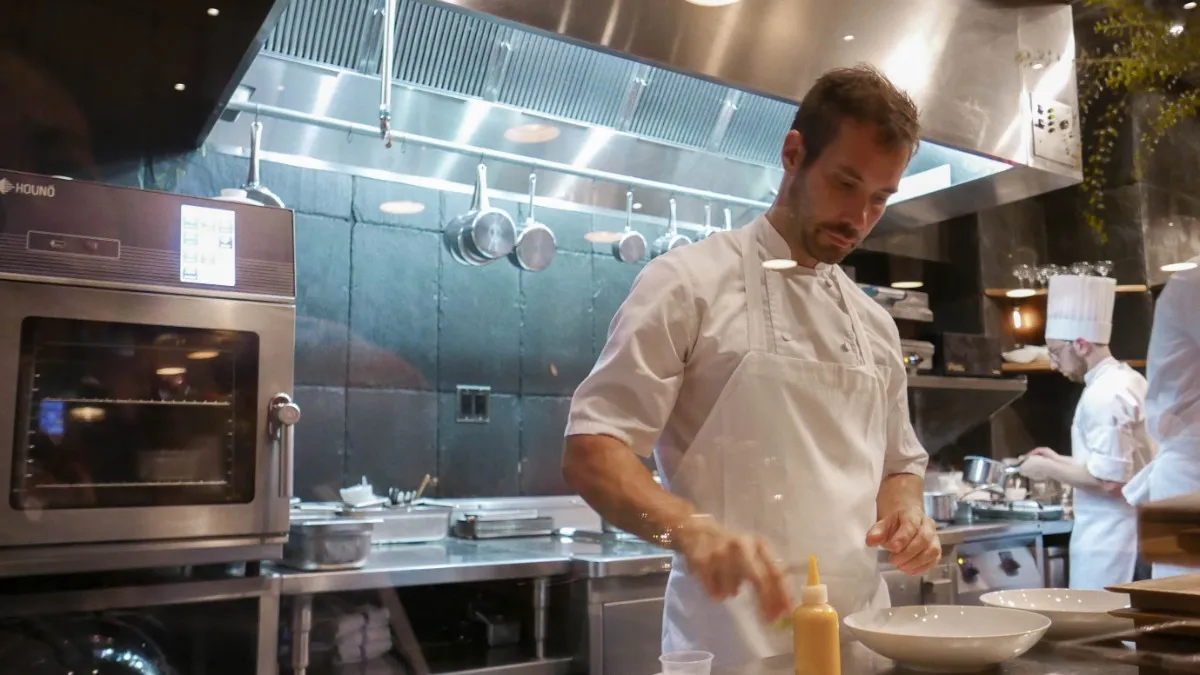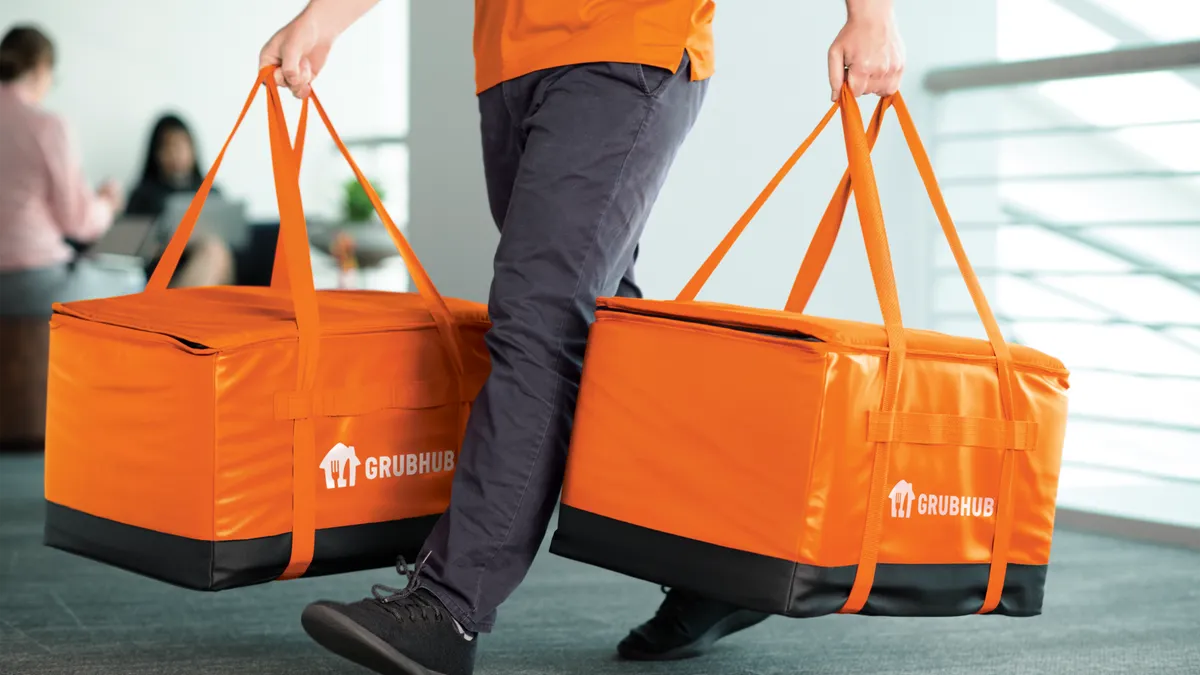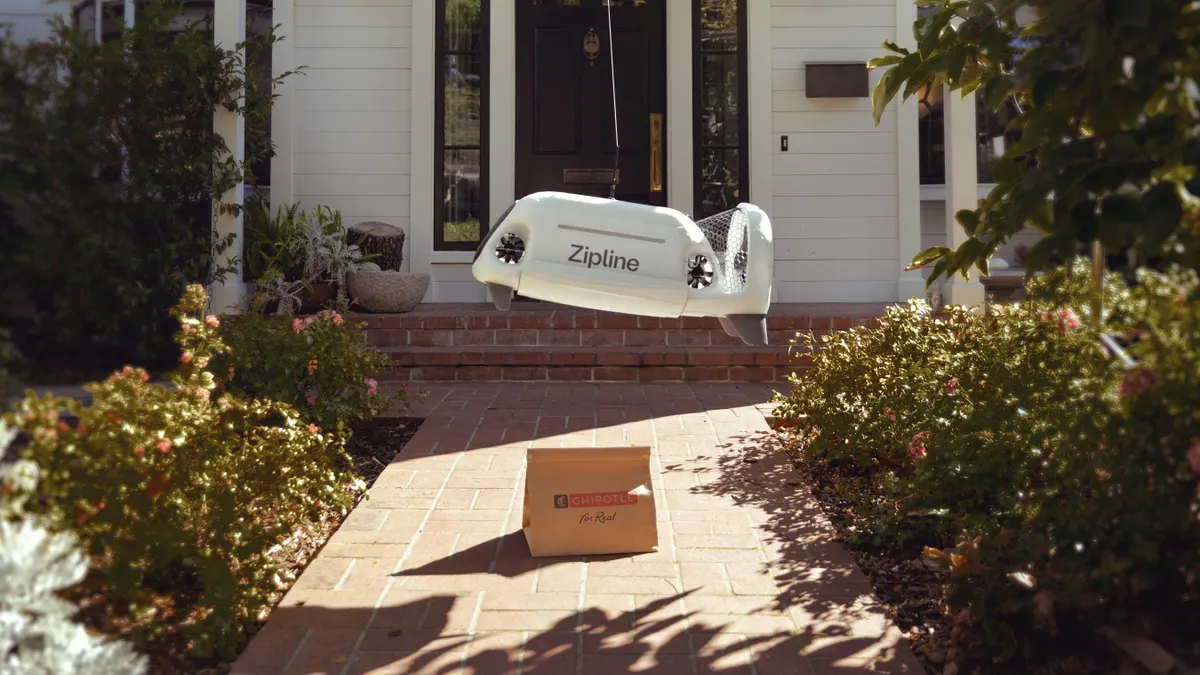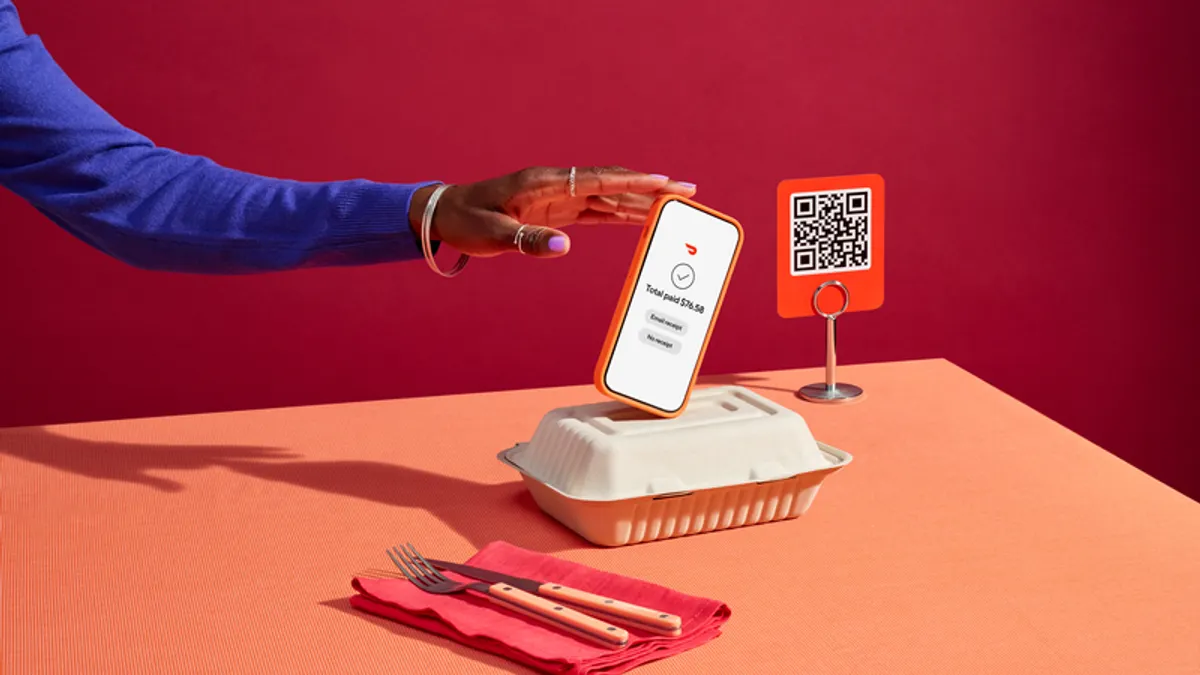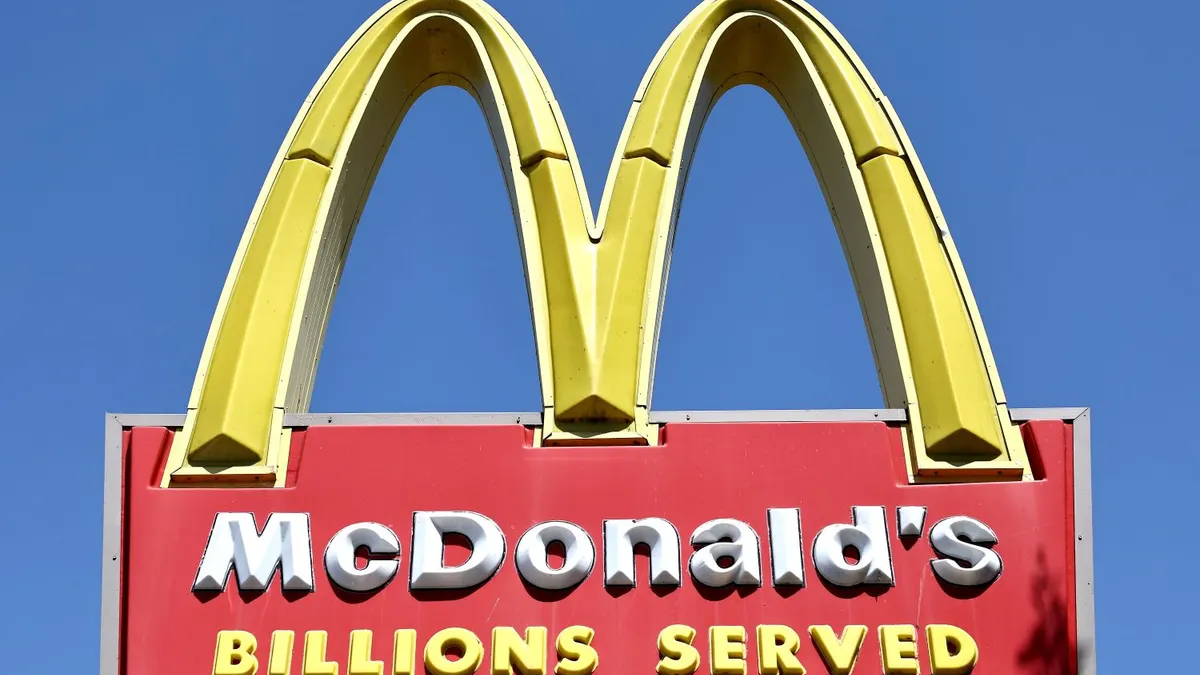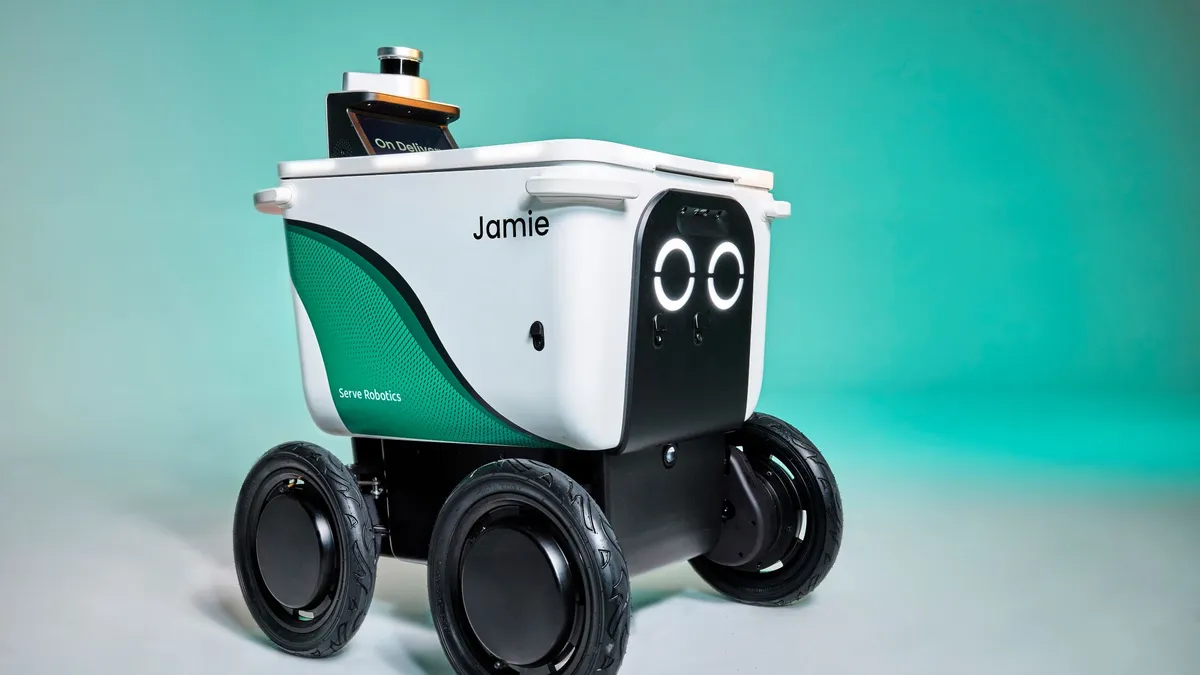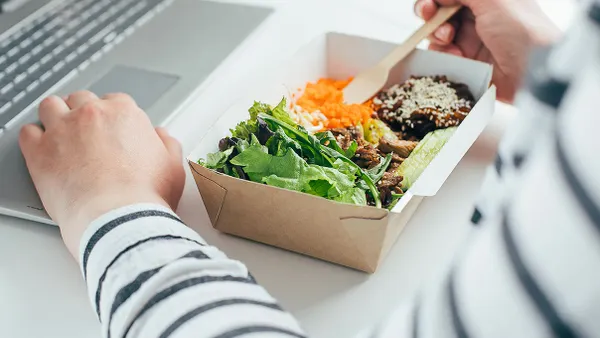This article is the sixth in a six-part series exploring the growth of the ghost kitchen market. The full series is posted here.
When rumors swirled last summer that a second dining room shutdown was on the horizon for Las Vegas, local restaurateur team Alexandra Lourdes and Lin Jerome knew they needed a big delivery idea — and fast — to survive.
The owners of Saint Honoré, a pastry shop specializing in doughnuts and beignets, had already laid off half of their employees during the pandemic. The eatery could only serve in-store guests at 50% capacity per Nevada's COVID-19 restrictions, and the cost of rent was a growing stressor, especially since the business was only open through 3 p.m. But that cost burden sparked an idea.
"We're paying rent 24/7, so why not utilize that space for extra revenue?" Lourdes said.
In just days, Lourdes and Jerome developed plans to use Saint Honoré as a ghost kitchen for a new virtual pizza brand, Pizza Anonymous, during its off-hours. The brand didn't require supply chain changes because it uses Saint Honoré dough materials and topping ingredients like meat and cheese from Lourdes' and Jerome's cafe concept, Café Lola. The extension into a new daypart also allowed Saint Honoré to bring back out-of-work employees, and required little cross-training since staff were already experts at making dough from scratch.
The team used Italian family recipes passed down to Jerome's husband to create four staple pizza offerings and a cheese bread, and sold leftover beignets from Saint Honoré's morning operations as dessert — squeezing extra revenue from its existing business.
The virtual brand gained traction immediately, selling out of allotted pizza orders on delivery platform Slice three hours before the shop even went live on July 31. Now, Pizza Anonymous operates out of both Saint Honoré and Café Lola, and Lourdes and Jerome said all of their future brick-and-mortar concepts will serve as ghost kitchens for the virtual brand. The restaurateurs are even speaking with realtors to look into new kitchen space for Pizza Anonymous during the pandemic.
"It's been performing very, very well. [Pizza Anonymous] definitely has the potential to do [as much in sales] as we're doing at our other locations, if not more, to be quite honest," Jerome said. "We could have been utilizing [a virtual brand] in the evening this entire time… I wish we would have jumped on this train a lot sooner than we did."
"We could have been utilizing [a virtual brand] in the evening this entire time… I wish we would have jumped on this train a lot sooner than we did."

Lin Jerome
Restaurateur, Saint Honoré, Café Lola, Pizza Anonymous
This sentiment reflects the U.S. restaurant market's growing awareness of ghost kitchen business opportunities. Interest in the segment is proliferating after casual dining profits wilted under dining room restrictions — with some municipalities completely reclosing indoor operations amid skyrocketing COVID-19 cases. The full-service restaurant segment isn't predicted to recover from the pandemic until 2025, according to Technomic data shared at a virtual FSTEC Community event in fall of 2020, Restaurant Business reports.
“We’re going to see a different industry,” Joe Pawlak, Technomic's managing principal, said at the event.
A flurry of investor interest
As delivery demand fuels cheaper service and accelerates the growth of delivery-only concepts, the ghost kitchen market could eventually capture 25% of dine-in service ($450 billion), 50% of drive-thru service ($75 billion) and 50% of takeaway foodservice ($250 billion), Euromonitor Global Food and Beverage Lead Michael Schaefer estimated during a virtual Euromonitor webinar in 2020.
Globally, the segment could be worth $1 trillion by 2030, Schaefer added, and investment in the space has accelerated significantly in 2020 alone.
The U.S. saw four notable funding rounds for different kinds of ghost kitchen companies in 2020. In July, Zuul landed $9 million to expand in New York City and launch a ghost food hall, and Virtual Kitchen — led by two former Uber executives and challenging ex-Uber CEO Travis Kalanick's $5 billion CloudKitchens — raised $20 million in September. In October, Ordermark, which connects restaurants looking to launch delivery-only formats with available host kitchens, scored $120 million. Reef Technology — which converts underutilized space like parking lots into ghost kitchen hubs — snagged $700 million in funding led by Softbank and Mubadala in November.
The scale of the American ghost kitchen market is still far smaller than China's sector, which boasts more than 7,500 ghost kitchens compared to roughly 1,500 in the U.S. But pandemic investment has crystallized three particular types of dark restaurant business models, bringing the market's possible future into focus.
Leveraging empty or underutilized real estate
To offset steep fixed overhead costs and better position offerings to capture elevated diner interest in delivery and curbside pickup as the pandemic drags on, some restaurants are banding together to operate out of the same kitchen.
"When you have foot traffic or restaurant traffic that's down 50% it's really hard to make that business work if your cost structure remains the same," John Kelly, CEO of technology firm Zenreach, said. "And so from the cost structure point of view, ghost kitchens can be very attractive. ... In many cases you can extract additional cost savings by sharing space and locations … and I do think that the industry is going to take a good hard look at costs."
Reoptimizing physical restaurant space could be one way restaurants adjust their cost structure, according to Schaefer.
"We expect in the current pandemic we'll see more of this repurposing, real estate operators doing anything they can to drive revenue from their existing properties. Likewise we're going to see a lot of new operators looking to fill the void with cheaper concepts, ... more delivery-friendly concepts that require less capital up front," Schaefer said.
Major restaurant companies were already using this strategy pre-pandemic to drive extra profitability from their existing footprints and help franchisees access a new revenue stream. Fat Brands, for example, has co-branded locations so that operators can run a sister brand virtually out of the brick-and-mortar store's existing kitchen. The restaurant group plans to apply this strategy to its newly acquired Johnny Rockets asset as well, expanding the delivery reach of its entire network without having to invest in new physical locations.
As independent restaurants and smaller chains explore the same strategy, ghost kitchen companies like Use Kitch, which helps restaurants link up with kitchens that are looking to rent out their space during quieter or off hours, are growing in popularity.
"From the cost structure point of view, ghost kitchens can be very attractive. … In many cases you can extract additional cost savings by sharing space and locations … and I do think that the industry is going to take a hard look at costs."

John Kelly
CEO, Zenreach
"There [are] a lot of kitchens out there that are being underused or totally unused, and COVID has [impacted] that in very acute ways," Use Kitch founder Dan Unter said. "We have seen supply open up based on mandatory closures or unfortunately just market-related closures due to the pandemic … and we see restaurants that are like 'We're busy from 6 p.m. to 2 a.m. ... And so we'd love to put a breakfast and lunch delivery operation out of our space during the rest of those times.'"
Use Kitch, which launched in January of 2020, allows commercial kitchens at businesses that are collecting dust, like hotel restaurants, to list the space they would like to rent out on their website like a kitchen Airbnb, Unter said. Kitchens can also list their available equipment, what permits and licenses they have in place, and requirements they are seeking in a restaurant partner, such as rental price and minimum lease commitment.
Unter said the company has seen engagement from first-time restaurateurs, brands with just one to two operations looking to give up their brick-and-mortar units to go completely digital, as well as chains with about 1,000 units looking to open a dozen locations to collect data in a new market.
"We kind of have a conservationist vibe about us. If you're reactivating a space that's already there, that's great. It means you don't have to build something new," Unter said. "I think that concept of a ghost kitchen is exciting. [You have] low cost of entry, flexible terms and you can do weird stuff [and] be innovative. … You don’t have to play to a base crowd."
This strategy could also reshape the restaurant landscape in areas that have been typically dominated by deep-pocketed legacy chains, such as Midtown Manhattan, Unter said. By entering existing kitchen space in areas like this, restaurants can carve out a delivery niche in a market they would not have been able to afford to enter via a typical brick-and-mortar model.
"Even if the contactless scenario fades a bit, even then you still have just an absolute ton of new demand and new reasons to expand your business," Unter said. "It's a new world. It's better to join the fun than fight it."
Turnkey, expandable solutions are on the rise
Companies like Reef and Kitchen Podular use nontraditional pieces of property, like parking lots and garages, to deploy modular ghost kitchen facilities and expand these hubs for restaurants across the country.
Reef considers itself an alternative to major host kitchen models like Kitchen United and Cloud Kitchens that have a fixed number of kitchen availability at their facilities and operate similar to a landlord for partner restaurants. Reef, on the other hand, controlled 5,000 parking lots and garages in the U.S. and Canada as of November, and can quickly open up 200-square-foot "kitchen vessels" inside shipping containers in these areas that can operate up to four to six brands.
"Much like the third-party delivery model upset the industry, I think that ghost kitchens are as well. Just like there are plenty of folks that are not happy about paying a very high percentage to the delivery platforms, I think there are a lot of folks looking at ghost kitchens… where you are basically just leasing space from a ghost kitchen landlord," Reef COO Carl Segal said. "I'm not sure how that model works for every brand. … You have to do enough business to make it profitable and make it worth your while."
By contrast, Reef licenses the brands of interested restaurants, learns its recipes and uses its own employees to make this food inside Reef kitchens. The brand doesn't require up-front capital costs and offers marketing support, and leverages a revenue sharing model to pay partners monthly.
"Most of the folks that we're working with through this are brands that have closed temporarily, and some of them are undecided about whether they're reopening," Segal said. "[The coronavirus] has really acted as a catalyst for the good, bad and the ugly of the restaurant world. … Everyone who had never considered even, frankly, putting their menus online on a lot of the delivery platforms jumped into that."
Reef will eventually add locations where diners can pick up their food from its kitchen hubs and even enjoy outdoor seating to prepare for a post-pandemic environment, Segal said. Kitchen Podular already operates this way, offering modular units that can accommodate pick-up windows and even drive-thrus if a restaurant wants to expand its off-premise services.
The difference between the two companies is ownership — Kitchen Podular sells its pods, which are customized based on a restaurant's needs, starting at $100,000 or about 50% less than a traditional food truck or real estate build, the company claims. Kitchen Podular ships these units fully-assembled directly to any site in the U.S. That amount could be steep for a small restaurant trying to stay afloat amid the pandemic, but could help a more established chain quickly scale its footprint for delivery as the closure of beleaguered independent restaurants widens market opportunity.
Barriers to future growth
Even as differentiated ghost kitchen models expand, these businesses still pose stumbling blocks for restaurants looking to maximize their revenue streams. Most major ghost kitchen providers, for example, work with major third-party delivery providers like DoorDash, Uber Eats, Postmates and Grubhub, which take a significant chunk of each sale from participating restaurants. It's difficult to quickly enter the delivery space without going through the "big four," which control 95% of the food delivery app marketplace, according to Second Measure data.
Many municipalities have enacted third-party delivery fee caps to protect vulnerable restaurant margins — San Francisco and New York City have limited commissions to 15%, for example — but there's no guarantee that these temporary reprieves will become permanent policies in a post-pandemic environment.
Because of these delivery partnerships, even though a restaurant can save on overhead costs by partnering with a ghost kitchen provider, they still need to generate enough orders to make up for delivery commission fees and charges by the ghost kitchen to turn a profit. This is easier said than done since food delivery apps are already crowded with known brands, and the dynamic has pushed restaurants to partner with smaller, more niche delivery providers — like Slice, in Saint Honoré's case — or to band together to afford to launch their own delivery fleet.
Lourdes and Jerome caution restaurants that are considering launching a ghost restaurant on their own to prioritize strategic social media marketing and to invest in branded packaging that can help a new concept’s stickiness with diners.
Traditional, real-estate focused ghost kitchen solutions have also drawn criticism because the space is difficult to regulate, and some restaurant opponents to the model argue that low-cost ghost kitchens undermine the economic stability of traditional local restaurants that can't compete with the scalability of digital brands. This was already a concern before the market's proliferation.
San Francisco planned a March 2020 hearing at City Hall to discuss ghost restaurants' impact on local, independent restaurants, for example, and began mulling potential legislation to regulate the city’s ghost kitchen scene in January. District 11 Supervisor Ahsha Safai told Eater in February that "San Francisco's not going to allow [ghost kitchens] to put our vibrant restaurant industry out of business. We will not allow that, for sure. They'll have to seek other environments to make their money."
At that time, the city was concerned the rise of these businesses could undermine the "vitality" of the neighborhood restaurant scene by increasing in-home food delivery at the detriment of eating out. The meeting was scheduled for March 12, around the same time shelter-in-place orders took effect around the country. It's unclear if that meeting took place.
The New York City Council held an oversight hearing in February 2020 to discuss ghost kitchens' influence on local restaurants, where entrepreneur and independent journalist Matt Newberg testified that he was concerned by what he perceives to be the growing power of ghost kitchen companies over restaurants and communities. He said that a Los Angeles Cloud Kitchens hub he visited housed 27 kitchens across 11,000 square feet and operated 115 delivery-only restaurants.
"Today, these kitchens plug into third-party delivery marketplaces like Uber Eats, Seamless, Postmates and DoorDash but tomorrow it could all exist on a single platform," he wrote. "It's quite analogous to Amazon."
He referenced a statement by early Uber investor Gary Vaynerchuk last summer, who said to attendees at a VaynerMedia event in regards to Cloud Kitchens, "It is unbelievable how much disruption is coming. The only thing that's going to be left is the brand, the affinity that the customer has for the brand and that's it."
"I fear that the diverse set of local restaurants around this neighborhood such as Sophie's Cuban Cuisine, Pisillo Italian Panini, Bombay's Indian Restaurant, and Leo's Bagels would be replaced with virtual concepts like: Fry Me A River, Italian Stallion, WTF is a Quesorito?!, Late Night Munchies, Panini Gang, Try Tasty Tacos, and Morning After. I'm not making these up," Newberg wrote.
But ghost kitchen platforms believe they possess the expertise to help partner restaurants leverage delivery better than they could on their own.
"While the off-premise market is booming, especially during this time, no brand can simply start up delivery and takeout and expect it to be a huge and immediate success," Kitchen United Chief Operating Officer Joy Lai said in a past interview. She stated that restaurants need a planned strategy that will allow them to draw in and engage customers while also executing off-premise smoothly.
It's certainly true that the rapid rise of ghost kitchen models could have unexpected consequences for traditional restaurant businesses. But amid an unprecedented pandemic and subsequent restaurant crisis, which experts predict is increasing diner delivery demand for the long-term, ghost kitchen hubs could provide lifeline for restaurants that would otherwise be forced to close to survive online. It’s a shift that could define a new restaurant industry future.
"I think you're going to see a change in who's running restaurants, and I don't think it’s going to be the 'hey I’m a great chef' restaurants because I don’t think those will have survived,” Johann Moonesinghe, CEO of restaurant finance company InKind, said. "It's really going to come down to the operation side… so you're gonna get this natural selection."
The Ghost Kitchens series is brought to you by Leer, a recognized leader in the temperature-controlled storage industry. To learn more visit their website. Leer has no influence over Restaurant Dive's coverage within the articles, and content does not reflect the views or opinions of Leer and its employees.



